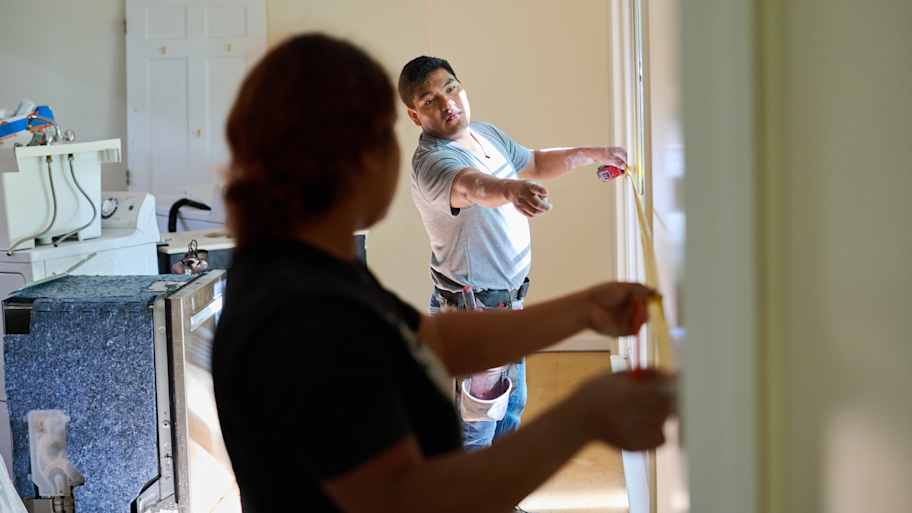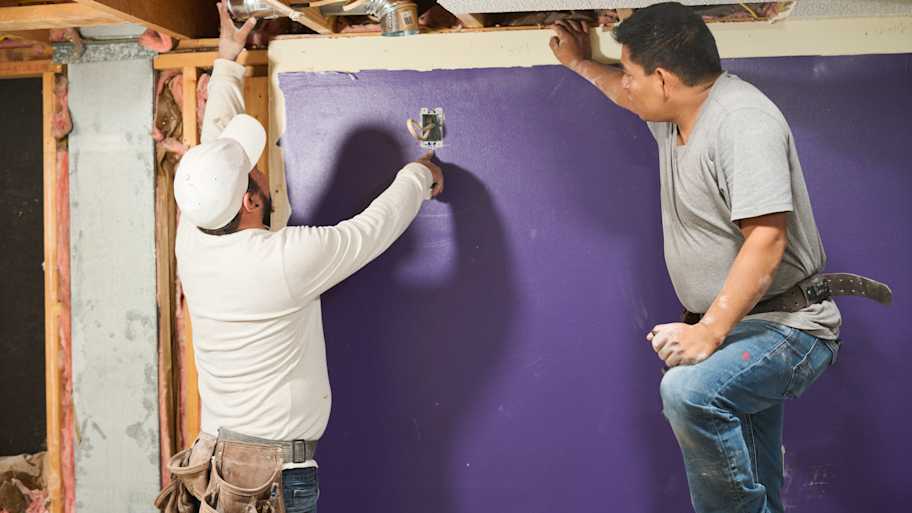How To Cut a Circle in Drywall in Under 60 Minutes
With the right tools and a steady hand, you can cut a circle in drywall on your own


- Utility knife
- Drywall saw
- Keyhole saw
- Drywall router
- Drywall t-square
- Drywall panels
- Measuring tape
- Straight edge or ruler
- Safety gear
- Drop cloth or plastic sheeting
In the world of DIY home improvement projects, knowing how to cut a circle in drywall can be a valuable skill. Whether you're installing a new light fixture, creating an access point, or adding a decorative element, mastering this technique can make your projects seamless and professional. In this guide, we'll walk you through the step-by-step process of cutting a circle in drywall. With the right drywall tools and a bit of know-how, you'll be able to tackle curved openings with confidence.
Prepare Your Work Area
 Photo: FreshSplash / E+ / Getty Images
Photo: FreshSplash / E+ / Getty ImagesBefore you start cutting any drywall, clear the area around it, removing any furniture or obstacles. You should also cover the floor with a drop cloth or plastic sheeting to catch any dust and debris. Don’t forget to protect yourself as well—put on safety glasses and a dust mask to protect your eyes and lungs from dust particles.
Measure and Mark the Center
 Photo: Johner Images / Johner Images Royalty-Free / Getty Images
Photo: Johner Images / Johner Images Royalty-Free / Getty ImagesNow, it’s time to determine the center point of the circle you want to cut. Use a tape measure to measure from the nearest edges to find the center and mark the center point with a pencil or marker.
Set the Compass
Once you know where the center point of the circle is, you can adjust the compass to the desired radius of your circle. Measure from the center point to the outer edge of the circle you want to cut.
Score the Circle
When you’re ready to score the circle and prepare it for deeper cuts, place your compass point at the center mark and gently rotate it to score the drywall's surface. It’s important to ensure that the compass stays upright while scoring.
Extend the Cut Lines
 Photo: v_zaitsev / iStock / Getty Images Plus / Getty Images
Photo: v_zaitsev / iStock / Getty Images Plus / Getty ImagesNext, you will extend the cut lines by using your drywall t-square to extend the scored lines, creating straight lines radiating from the center point to the edge of the circle.
Cut the Circle's Perimeter
With your utility knife, carefully cut along the extended lines, forming the outer edge of the circle. Apply firm but controlled pressure to avoid tearing the drywall.
Create an Access Hole
In the center of the circle, create a small access hole with your utility knife. This will allow you to insert the jigsaw blade.
Cut the Circle with a Jigsaw
 Photo: photovs / iStock / Getty Images Plus / Getty Images
Photo: photovs / iStock / Getty Images Plus / Getty ImagesNow that you have created an access hole, you can insert the jigsaw blade through it. You can accomplish this by starting the jigsaw and guiding it along the circular line, following the scored edge. Keep a steady hand and move the jigsaw slowly to maintain a smooth cut. Be cautious as you approach the end of the cut to prevent any splintering or tearing.
Clean Up
Once you are done cutting your circle, turn off the jigsaw and remove it from the access hole. Gently sand the cut edges of the circle with sandpaper to smooth any rough spots.
Patch and Finish
 Photo: eyjafjallajokull / iStock / Getty Images Plus / Getty Images
Photo: eyjafjallajokull / iStock / Getty Images Plus / Getty ImagesIf you're creating the hole for a specific purpose, such as installing a light fixture or access panel, you may not need to patch the hole. If patching is required, use a joint compound and a putty knife to fill any gaps or seams around the cut circle. To do this, you will need to apply mesh tape to reinforce the seams and let it dry completely. Then, sand the patched area smoothly and repaint it to match the surrounding wall.
DIY vs. Hiring a Pro
Cutting a circle in drywall yourself can cost as little as the price of a jigsaw, utility knife, and other basic tools, which may total around $50 to $100–or less, if you already have them on hand. Hiring a professional drywall installer, however, can cost significantly more, with labor costs ranging from $100 to $300 or more, depending on the complexity of the job.
Additionally, professionals may charge extra for materials and patching or drywall installation, making the DIY approach more cost-effective for simpler cuts. That being said, if you don’t own any of the tools or supplies needed for this project, you could end up spending more to do the work yourself. You should price both options to determine which is more cost-effective for you.
Frequently Asked Questions
The best tool for cutting a hole in drywall is a drywall saw. Its serrated blade and ergonomic design make it efficient for both straight cuts and more intricate shapes, ensuring clean and precise results in various drywall cutting applications.
A jigsaw is commonly used to cut holes in drywall. It offers versatility and precision, making it suitable for creating circular or irregular openings. When equipped with the right blade, a jigsaw can swiftly and cleanly cut through drywall, making it a good choice for DIY projects.















